
| Version | Summary | Created by | Modification | Content Size | Created at | Operation |
|---|---|---|---|---|---|---|
| 1 | Yinlei Sun | -- | 5803 | 2022-11-18 03:51:35 | | | |
| 2 | Amina Yu | Meta information modification | 5803 | 2022-11-18 04:06:48 | | | | |
| 3 | Amina Yu | + 2 word(s) | 5805 | 2022-11-25 03:51:06 | | | | |
| 4 | Amina Yu | Meta information modification | 5805 | 2022-11-25 08:55:22 | | |
Video Upload Options
Red soil, widely distributed in South America, Africa and Southeast Asia (approximately between the 30° S and 30° N latitudes), is formed by the weathering of carbonate or other rocks rich in iron and aluminium oxides in hot and humid climates. The concept of problem soils was first proposed by Wiseman et al. (1988), and it received a rapid response from the international soil community. Problem soils have a wide horizontal distribution range and large longitudinal depth. Such soils represent a relatively difficult research object in the soil mechanics domain, and the related research is thus a key field of geotechnical engineering. At the 2004 International Conference on Progress in Geotechnical Engineering, Evans et al. indicated that red soil, as a type of problem soil, is prone to geological disasters. Red soil is a highly sensitive problem soil in the Earth’s crust, owing to its hydrologic characteristics and chemical behaviour, and is known as problematic red soil. In rain or a full water system, under the influence of physical and chemical solutions, the original water-soil composition and structure and micro-cracks in the problem soil are destroyed, and the variation in the physical and chemical fields changes the mechanical properties of the soil, which may result in critical disintegration and other types of deformation and failure. These geological hazards are closely related to the intergranular suction, which, in turn, is related to the mechanical properties of unsaturated red soil, and may threaten building foundations and project construction.
1. Factors Influencing Red Soil Disintegration
1.1. Water
Initial Moisture Content
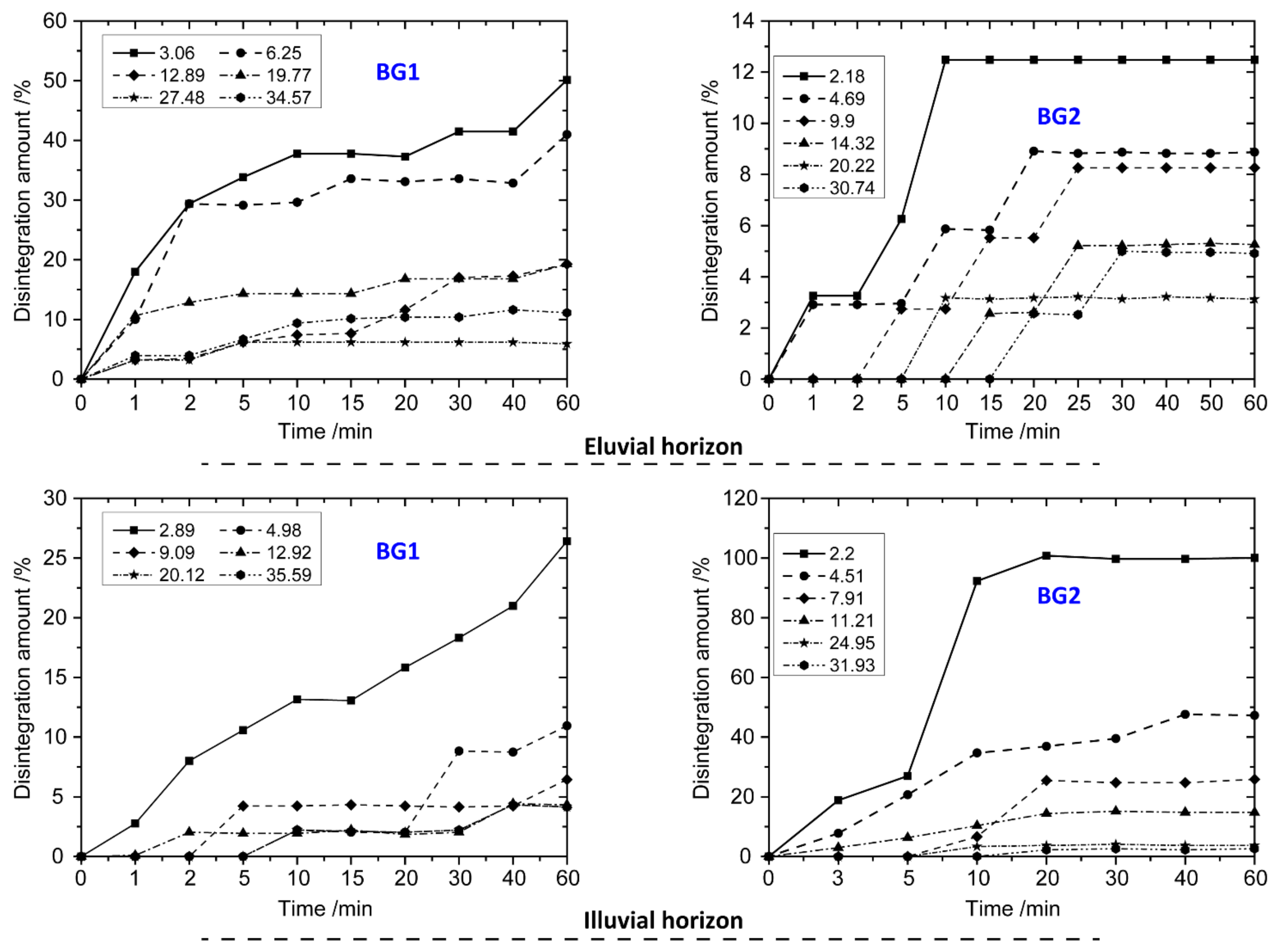
Wet-Dry Cycle
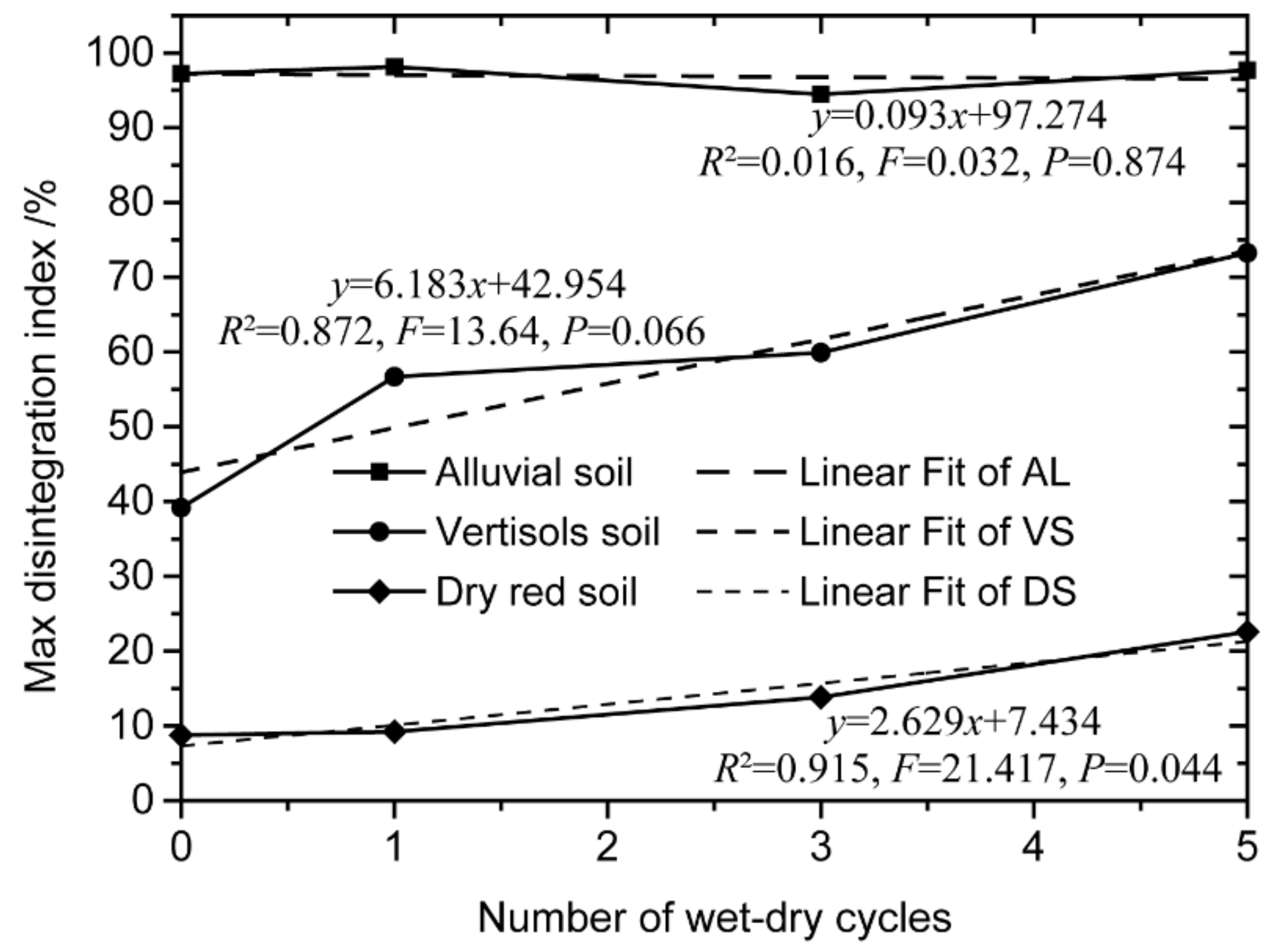
Moisture Content of Remoulded Soil
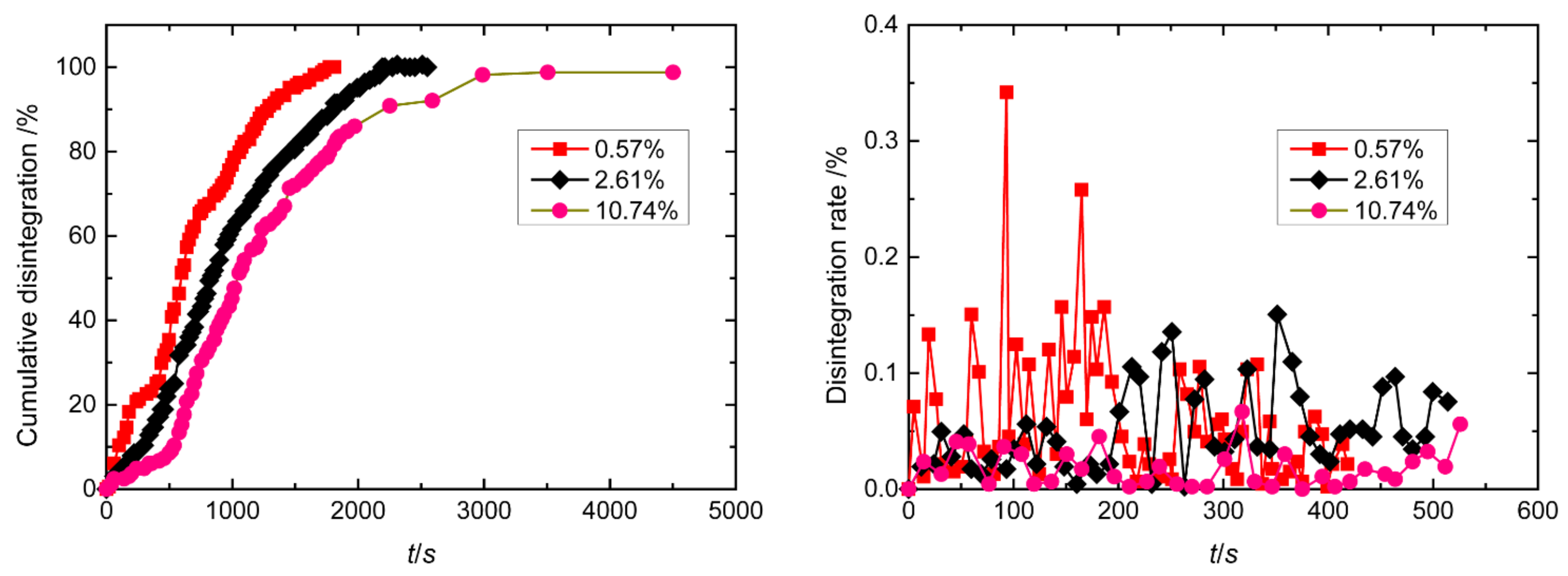
1.2. Temperature
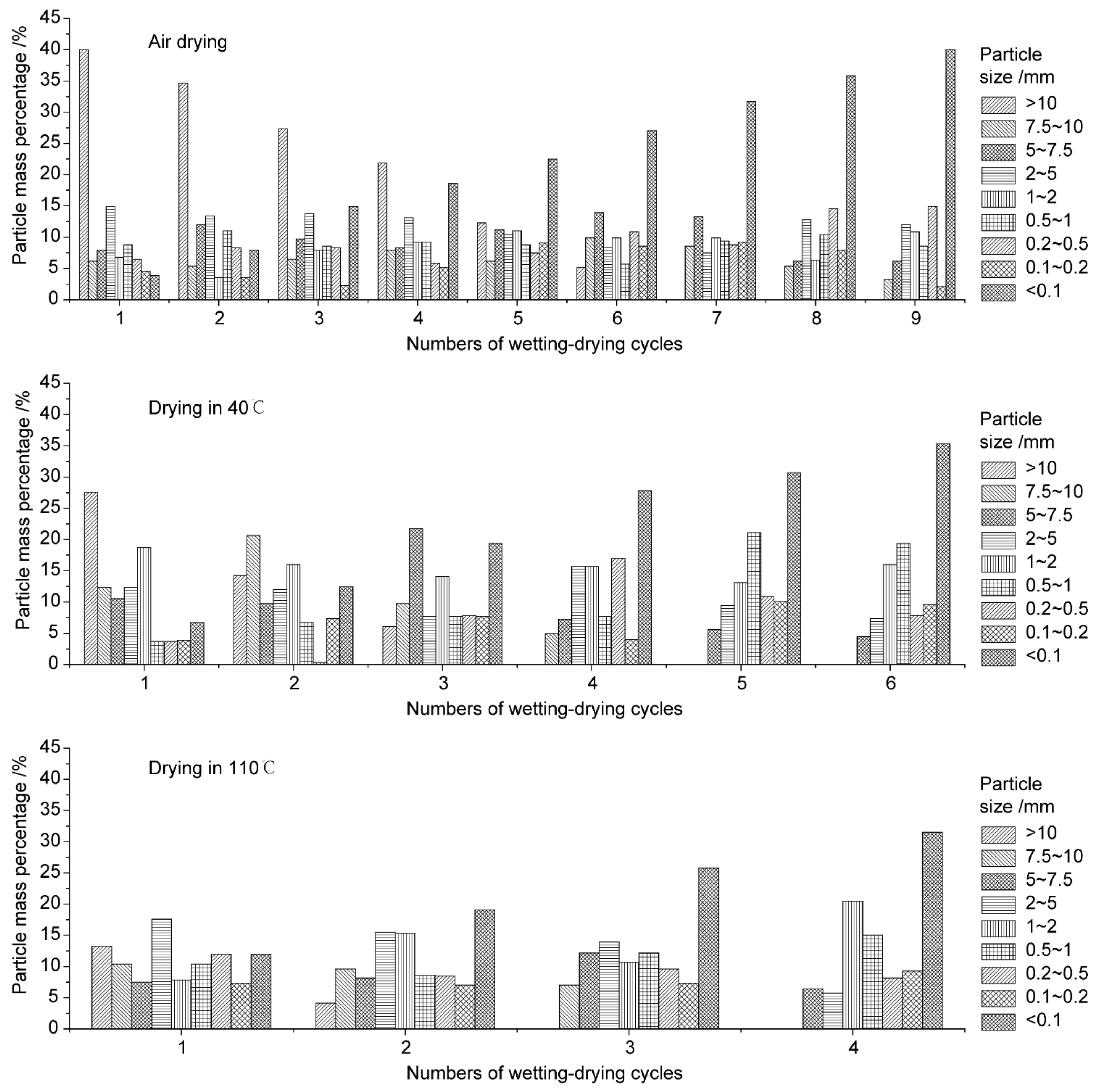
1.3. Pore Air Pressure
1.4. Mineral Composition
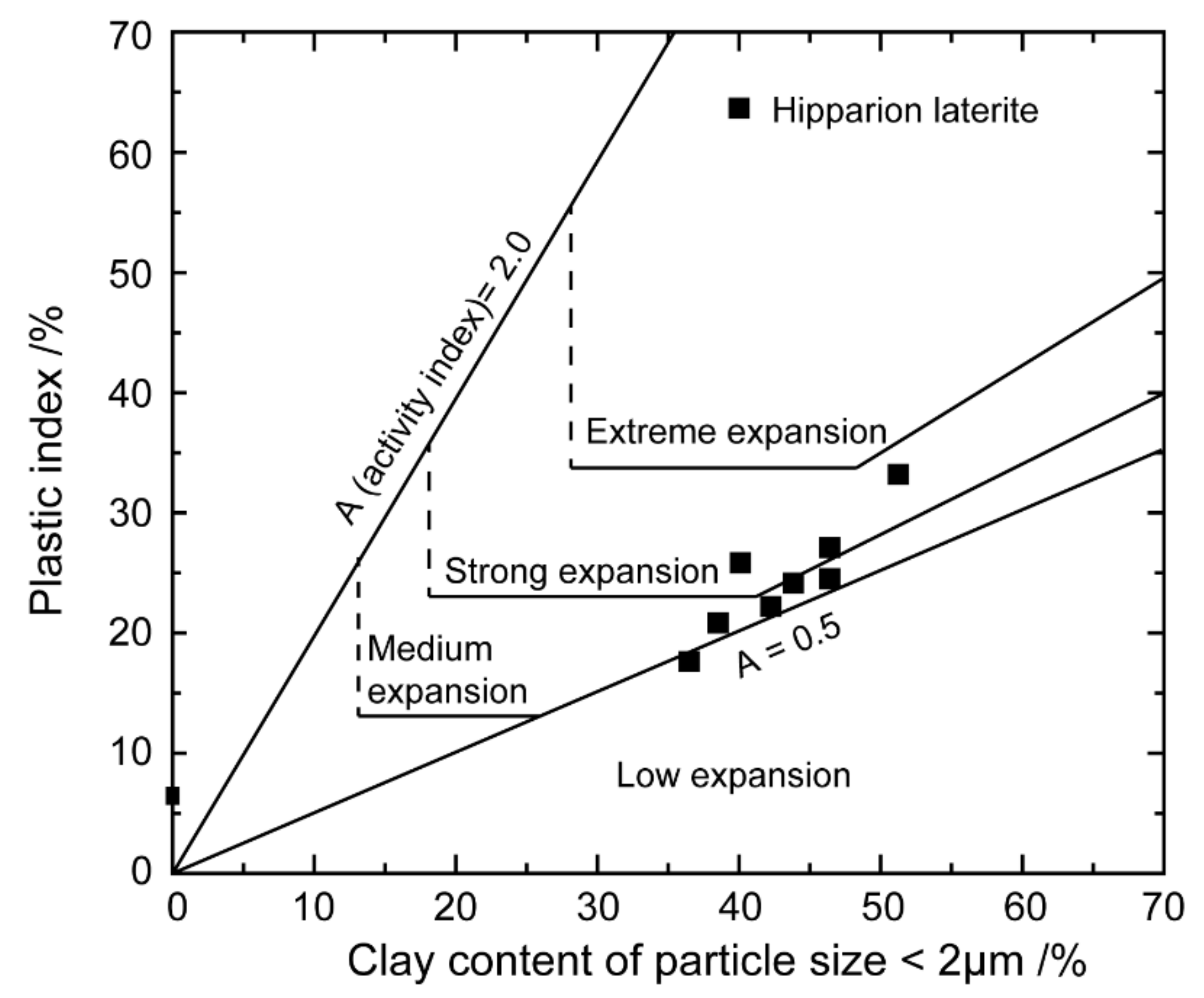
1.5. Microstructure Change
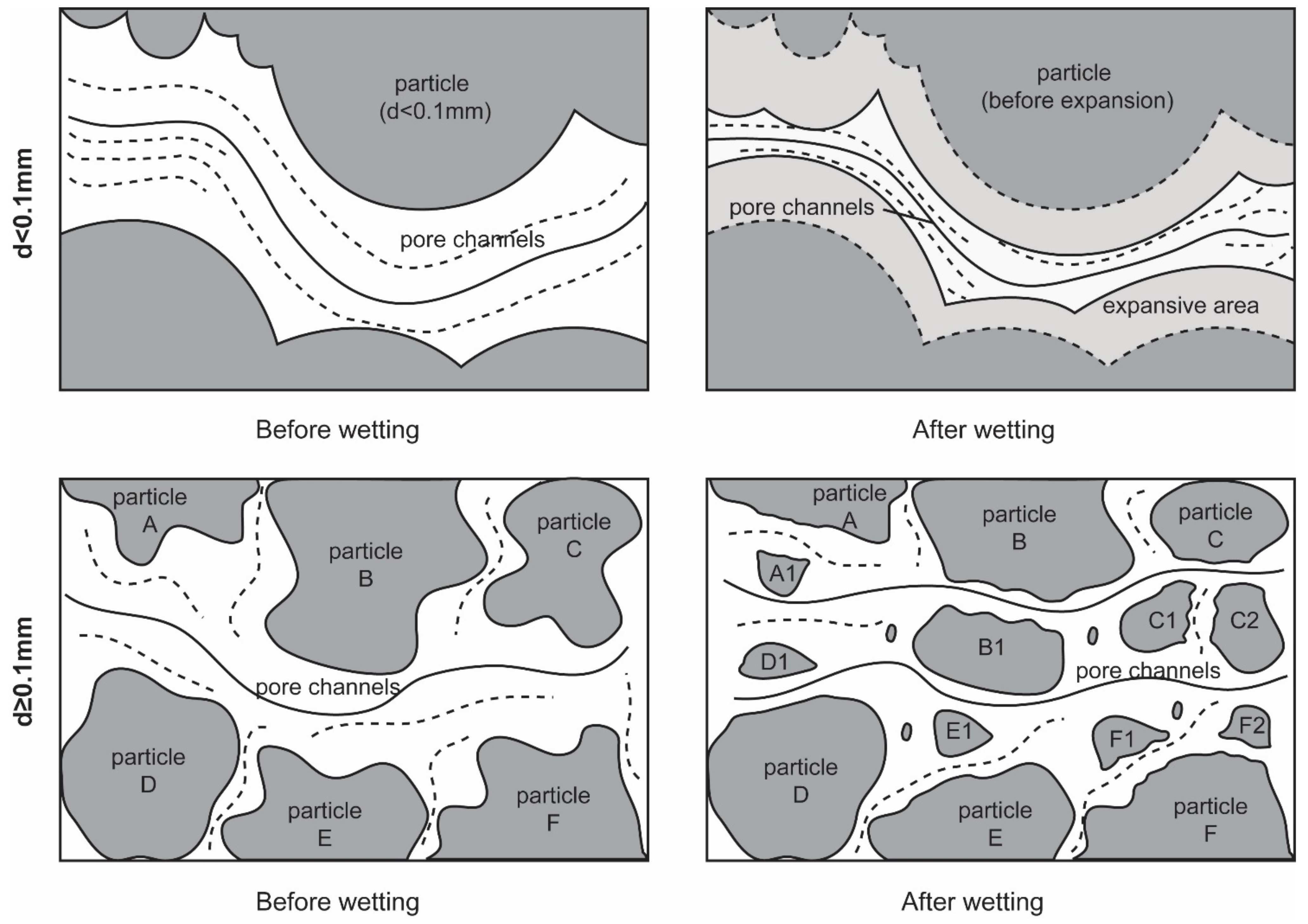
1.6. pH
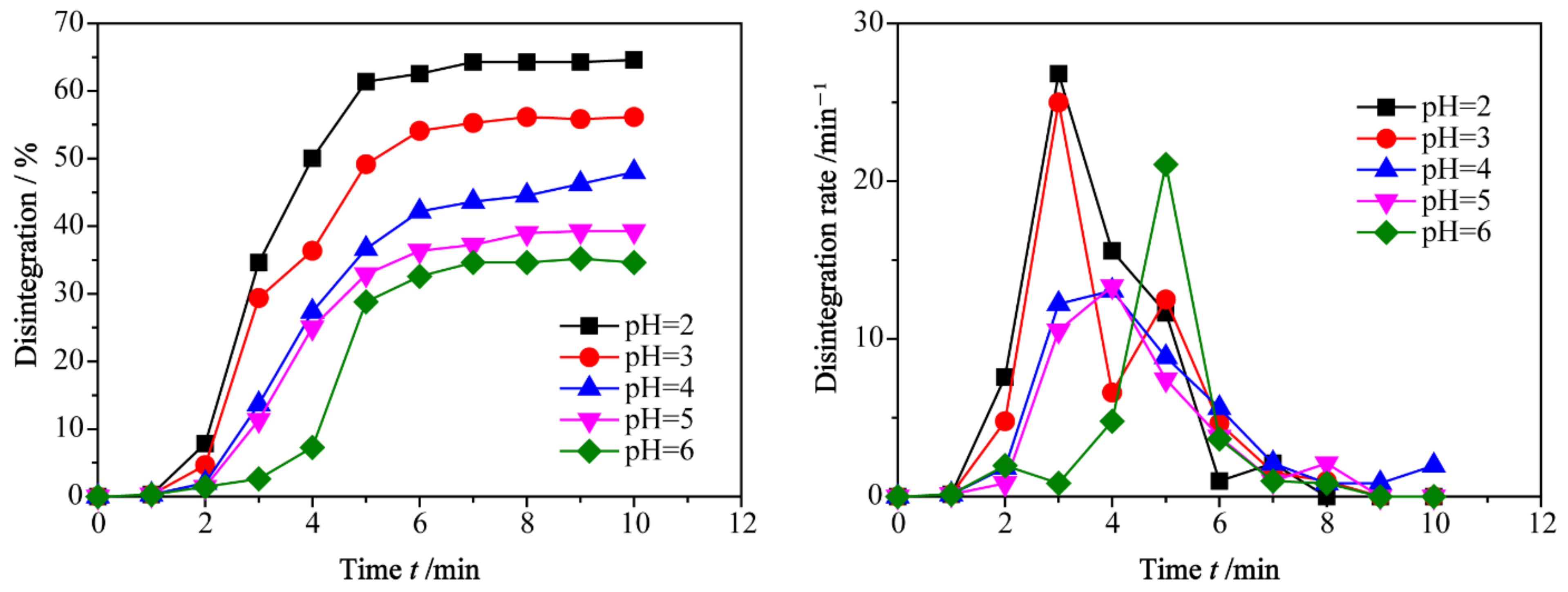
1.7. Multifactor

2. Disintegration Testing Methods
2.1. Laboratory Test
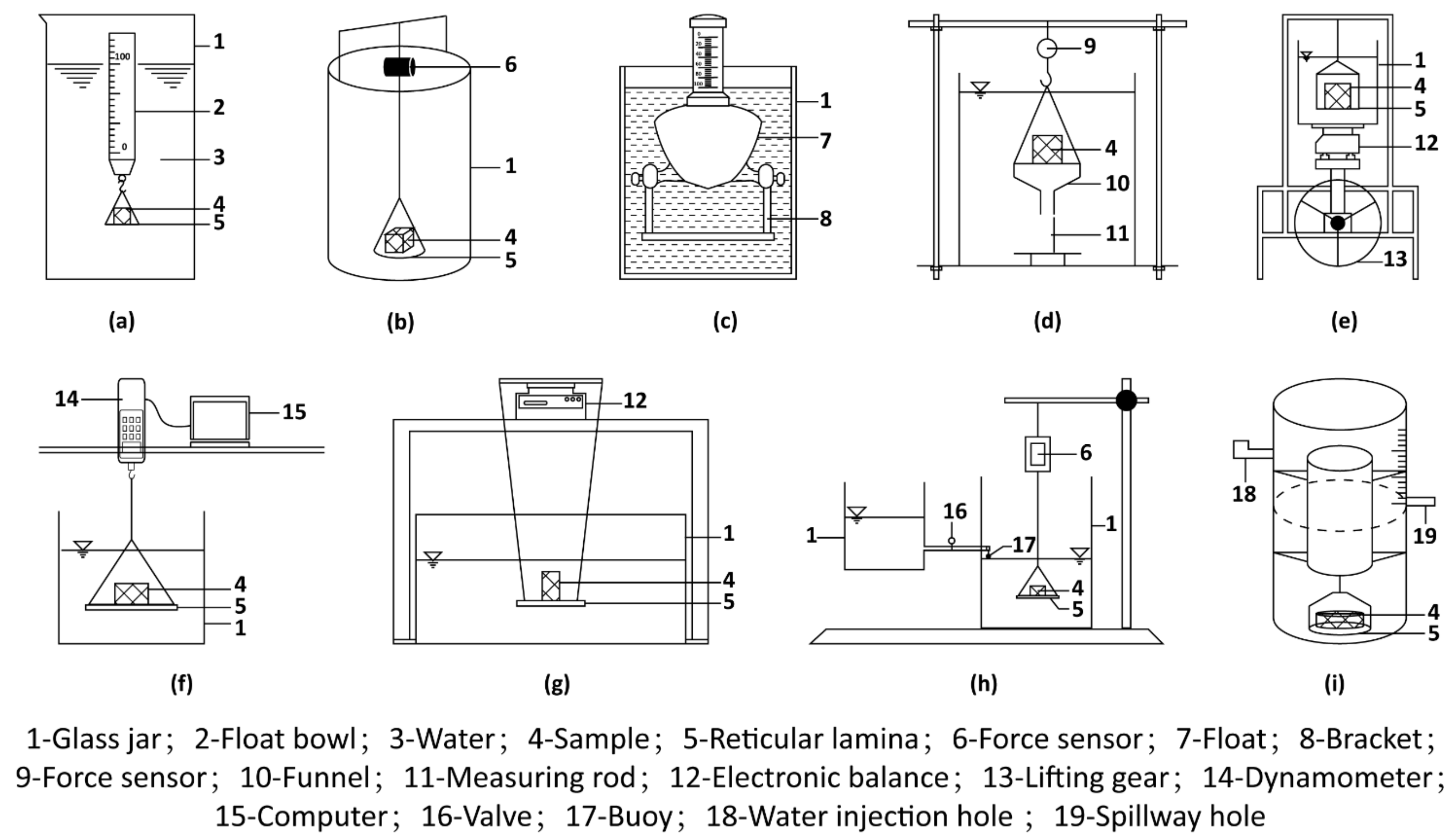
2.2. Numerical Method
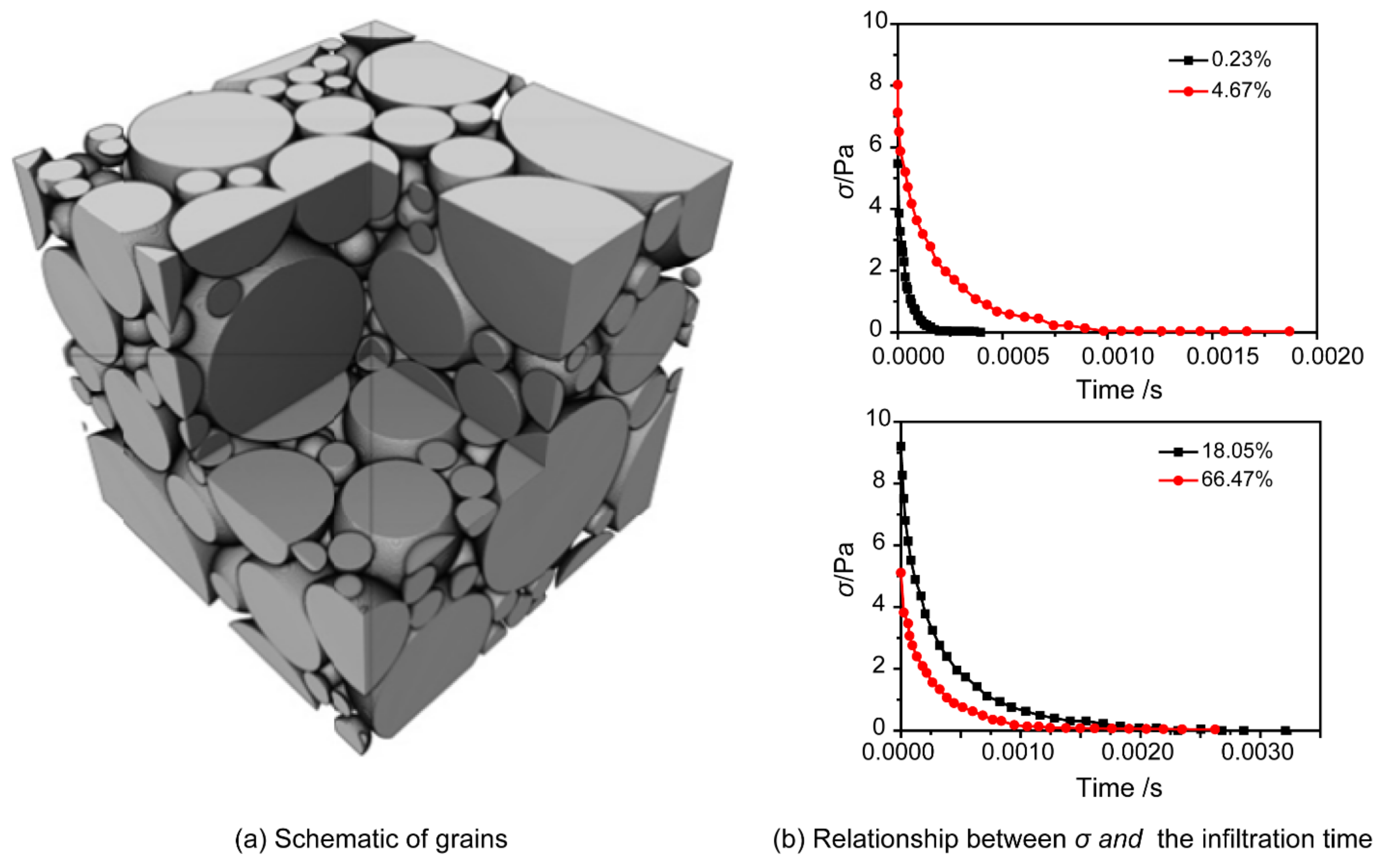
References
- Cassell, F.L. Slips in fissured clay. In Proceedings of the Second International Conference on Soil Mechanics and Foundation Engineering, Rotterdam, The Netherlands, 21–30 June 1948.
- Dudley, J.H. Review of collapsing soils. J. Soil Mech. Found. Eng. 1970, 96, 925–947.
- Foss, I. Red soil from Kenya as a foundation material. Proceedings of 8th International Conference on Soil Mechanics and Foundation Engineering, Moscow, Russia, 15–19 August 1973.
- Yudhbir, Y. Collapsing behaviour of collapsing soils. Proceeding of the 7th Southeast Asia Geotechnical Conference, Hong Kong, China, 22–26 November 1982.
- Popescu, M.E. A comparison between the behaviour of swelling and of collapsing soils. Eng. Geol. 1986, 23, 145–163.
- Lawton, E.C.; Fragaszy, R.J.; Hardcastle, J.H. Collapse of compacted clayey sand. J. Geotech. Eng. 1989, 115, 1252–1267.
- Tadepalli, R.; Fredlund, D.G. The collapse behaviour of a compacted soil during inundation. Can. Geotech. J. 1991, 28, 477–488.
- Lawton, E.C.; Fragaszy, R.J.; Hetherington, M.D. Review of wetting induced collapse in compacted soils. J. Geotech. Eng. 1992, 118, 1376–1394.
- Wang, M. The interaction between water and clay particles in saturated clayey soils. Hydrogeol. Eng. Geol. 1987, 3, 5–16.
- Wang, Y.; Wang, Y. Effects of soil-water interaction on the flow in soil fissure. Chin. J. Rock Mech. Eng. 1999, 18, 554–557.
- Wang, Z.; Gong, B.W.; Bao, C.G. Measurement of matrix suction of expansive soil slope in Northern Hubei. Chin. J. Geotech. Eng. 2001, 25, 304–307.
- Liao, Y.L. Interaction between three phases of cohesive soil and its effects on related indexes. Geotech. Investig. Surv. 2001, 6–8.
- Zhang, X.G.; Wu, H.; Fang, C. Analysis of X-Ray Diffraction on Variation of Soil Ministructure and Interaction Between Groundwater and Soil. J. Guilin Univ. Technol. 2005, 25, 37–40.
- Hu, G.F.; Wang, J.; Cai, X.F. Advances in the Effects of Initial Water Content on Soil Erosion. Guizhou Agric. Sci. 2013, 41, 100–103.
- Liu, D.W.; Xiong, C.R. Experimental Study on Properties of Red Sandstone for Road Applications. Cent. South Highw. Eng. 2002, 22, 19–22.
- Kong, L.W.; Chen, Z.H. Advancement in the techniques for special soils and slopes. China Civ. Eng. J. 2012, 45, 141–159.
- Zheng, M.Z. Disintegration Behavior of Residual Soil and Nonlinear Time Series Analysis for Its Slope Displacement. Master’s Thesis, Fuzhou University, Fuzhou, China, 2005.
- Cai, X.L. Study on disintegration characteristics of granite residual soil. Water Conserv. Sci. Technol. Econ. 2010, 16, 882–883.
- Xue, L.; Li, X.H. Study on Disintegrating Property of Granodiorite Residual Soil and Completely Strong Weathered Rock. Subgrade Engineering 2011, 144–147.
- Zeng, P. A Study Compaction Characteristics and Disintegration Behavior of Granite Residual Soil. Master’s Thesis, South China University of Technology, Guangzhou, China, 2012.
- Jian, W.B.; Hu, H.R.; Luo, Y.H.; Tang, W.Y. Experimental study on deterioration of granitic residual soil strength in wetting-drying cycles. J. Eng. Geol. 2017, 25, 592–597.
- Li, C.S.; An, R.; Shu, R.J.; Kong, L.W. Initial-disintegration analysis of granite residual soil and approximate simulation of mathematical morphology. Chin. J. Rock Mech. Eng. 2020, 39, 201–210.
- Liu, D.L.; Zhao, Y.; Ding, S.W.; Deng, Y.S.; Wang, Q.X.; Lv, G.A. Correlation between initial soil moisture content and the characteristics of collapsing gullies in granite regions. Sci. Soil Water Conserv. 2016, 14, 17–22.
- Li, Z.; Liu, Y.W.; Zhao, J.F. In-door Experiment of Granite Weathered Residual Soil Disintegration at Sea-cliff. Water Power 2018, 44, 107–110.
- Zhou, C.Y.; Jing, X.D.; Liu, Z. Disintegration characteristics and modification of weathered soil in red beds in Southern China. J. Eng. Geol. 2019, 27, 1253–1261.
- Wang, Y.F.; Niu, J. Soil Disintegration Rate in the Upper and Middle Reaches of the Yangtze River. J. Yangtze River Entific Res. Inst. 2015, 32, 40–43.
- Zhu, Z.Y.; He, G.C.; Li, F.X.; Wang, Z. Experimental Investigation on the Failure Mechanism of Red Soil Slope under Cyclic Wetting and Drying. J. Yangtze River Sci. Res. Inst. 2018, 35, 73–77.
- Zhang, F.Z.; Chen, X.P. Influence of repeated drying and wetting cycles on mechanical behaviors of unsaturated soil. Chin. J. Geotech. Eng. 2010, 32, 41–46.
- Tang, J.; Yu, P.; Wei, H.Z.; Meng, Q.S. Slaking behaviour of weathered basalt residual soil in Guizhou. J. Eng. Geol. 2011, 19, 778–783.
- Chen, D.X.; Yang, Y.; Yang, K.; Kang, K.G. Experimental study on strength and water-stable behavior of unsaturated residual soils. In Proceedings of the International Conference on Remote Sensing, Environment and Transportation Engineering, Nanjing, China, 24–26 June 2011.
- Zhao, G.G.; Huang, Y.; Zhang, J.F.; Cheng, F.Y.; Zhou, Z.W. Investigation on the Development of Cracks of Laterite of Yunnan Under Wetting-drying Cycles. J. Soil Water Conserv. 2017, 31, 157–165.
- Zhang, S.; Zheng, X.Y.; Xiong, D.H.; Zhang, B.J.; Yang, D.; Guo, M.; Jiao, L. The Influence of Dry-wet Alternation on the Disintegration of Different Types of Soil in Gully Development Region of Dry-hot Valley. J. Soil Water Conserv 2016, 30, 111–121.
- Yan, B.; Tang, L.S.; Hu, H.; Wang, D.Z.; Lin, G.W. The mechanism of disintegration damage of granite weathered soil. Hydrogeol. Eng. Geol. 2009, 36, 68–70.
- Huang, Z.P.; Sun, J.L.; Cao, Y.B.; Zeng, H.J. Temperature effect on strength evolution of saturated granite residual soil. Nonferrous Met. (Min. Sect.) 2017, 69, 54–60.
- Zeng, Q.J.; Liu, B.C.; Zhang, B.H.; Xiong, J.H.; Xiao, S.D. An experimental study of the disintegration characteristics of red clay. Hydrogeol. Eng. Geol. 2018, 45, 99–103.
- Wang, Y.; Tang, L.S.; Gao, Q.C.; Liao, H.R. Effects of Water-Soil Interaction on Mechanical Strength of Residual Red Clay. Acta Sci. Nat. Univ. Sunyatseni 2007, 46, 128–132.
- Zhang, B.H.; Xie, Y.H.; Liu, L. Water absorption of red clay and its influence on the slaking test. Soil Eng. Found. 2020, 34, 98–101.
- GambleGamble, J. Durability-Plasticity Classification of Shales and Other Argillaceous Rocks. Ph.D. Thesis, University of Illinois at Urbana-Champaign, Champaign, IL, USA, 1971.
- Yamaguchi, H.; Yoshida, K.; Kuroshima, I.; Fukuda, M. Slaking and Shear Properties of Mudstone. Rock Mech. Power Plants 1988, 1, 133–144.
- Tang, Q.Y. A Study on the Temperature Effect on the Structural Strength of Granite Residual Red Soil. Master’s Thesis, Jilin University, Changchun, China, 2005.
- Zhang, X.W.; Kong, L.W. Experimental investigation on relative contribution of hot and humid weather and heavy rainfall in disintegration of basalt residual soil. Sci. Sin. 2016, 46, 1175–1184.
- Guo, T. Study on Disintegration Properties and Microstructure of Guilin Red Clay under Different Environmental Conditions. Master’s Thesis, Guilin University of Technology, Guilin, China, 2017.
- Sun, Y.L.; Tang, L.S.; Liu, J. Advances in research on microstructure and intergranular suction of unsaturated soils. Rock Soil Mech. 2020, 41, 1095–1122.
- Chugh, Y.P.; Missavage, R.A. Effects of moisture on strata control in coal mines. Eng. Geol. 1981, 17, 241–255.
- An, R.; Kong, L.W.; Li, C.S.; Luo, X.Q. Strength attenuation and microstructure damage of granite residual soils under hot and rainy weather. Chin. J. Rock Mech. Eng. 2020, 39, 1902–1911.
- Xia, D.; Zhao, B.Q.; Liu, D.X.; Deng, Y.S.; Cheng, H.; Yan, Y.J.; Ding, S.W.; Cai, C.F. Effect of soil moisture on soil disintegration characteristics of different weathering profiles of collapsing gully in the hilly granitic region, South China. PLoS ONE 2018, 13, e0209427.
- Zhang, X.W.; Kong, L.W.; Li, H.C. Engineering geological properties and micro-mechanism of residual soils derived from mudstone in Harare, Zimbabwe. J. Eng. Geol. 2018, 26, 1424–1432.
- Zhang, H.Z.; Liu, J.F. Microstructures, Mineral Compositions, and Mechanical Properties of Red-Layers in Southern China. Adv. Mater. Sci. Eng. 2018, 2018, 9601386.
- Zhang, S.; Tang, H.M. Experimental study of disintegration mechanism for unsaturated granite residual soil. Rock Soil Mech. 2013, 34, 1668–1674.
- Reginatto, A.R.; Ferrero, J.C. Collapse potential of soils and soil-water chemistry. Int. J. Rock Mech. Min. Sci. Geomech. 1975, 12, 59.
- Cheng, B.C.; Xu, C.W. Property of the Cementing Material and Its Influence on Mechanical Characteristics for Residual Soil from Granite. Rock Soil Mech. 1986, 7, 64–69.
- Wang, Q.; Jiang, H.Z.; Tang, D.X. Study on engineering geological properties of granite residual soil in South Fujian. Geol. Fujian 1990, 9, 90–99.
- Wang, Q.; Tang, D.X.; Zhang, Q.Y.; Zhao, J.Z. A study on the material structure and composition of granite residual soils in the eastern China. J. Chang. Univ. Earth Sci. 1991, 21, 73–81.
- Chen, Q.; Li, J.; Zhao, L. Experimental Research on Disintegration Characteristics of Weathered Granite in Nanyue Region. Chin. J. Undergr. Space Eng. 2015, 11, 119–124.
- Huang, Y.; Fu, B.C.; Fu, J.Q.; Li, Q.S. The Section Properties of the Substance Composition of the Basalt Laterite in Kunming Area. J. Kunming Univ. Sci. Technol. 2000, 25, 88–92.
- Liu, C.W.; Lu, S.L. Research on mechanism of mudstone degradation and softening in water. Rock Soil Mech. 2000, 21, 29–31.
- Tan, L.R. Discussion on mechanism of disintegration and argillitization of clay-rock. Rock Soil Mech. 2001, 22, 1–5.
- Zhou, H.Y.; Li, H.X. The Study on Soil Disintegration Characteristics and Its Influence Factors of Collapsing Wall in the Collapsing Hill Erosion Region of Southern China. J. Soil Water Conserv. 2017, 31, 74–79.
- Wang, J.Z. The dffects of free iron Oxides on the engineering properties of red clay. Chin. J. Geotech. Eng. 1983, 5, 147–156.
- Jin, X.; Xiong, C.X.; Zhong, F.L. Experimental Study on Disintegration Characteristics of Granite Residual Soil Under Acid Pollution. J. Water Resour. Archit. Eng. 2017, 15, 194–198.
- Li, B.; Wu, S.R.; Shi, J.S.; Feng, Z. Engineering geological properties and hazard effects of Hipparion laterite in Baoji, Shaanxi Province. Geol. Bull. China 2013, 32, 1918–1924.
- Gao, G.R. The Microstructures and Engineering Properties of Red Soil in China. J. Geotech. Eng. 1985, 7, 10–21.
- Feng, J.L.; Zhao, Z.S.; Gao, G.R. An Exploration for Action and Action Mechanisim of Free Ferric Oxide in Laterite. J. Hebei Acad. Sci. 1994, 1, 35–43.
- Zhang, Z.; Ma, W.; Zhao, S.P.; Feng, W.J.; Wu, J.J.; Xiao, D.H. Morphological characteristics of the disintegration of cryogenic clay loam, natural and air-dried. J. Glaciol. Geocryol. 2014, 36, 118–122.
- Xu, Q.Y.; Wang, H.; Wu, J. Preliminary research on the factors affecting the disintegration characteristics of soil. J. Eng. Geol. 2016, 24, 855–860.
- Xu, H.D.; Wu, S.L. Countermeasures for the Prevention and Control of the Disintegration Disaster Caused by the Yuan Baoshan Red Soil in North China. J. China Univ. Min. Technol. 1996, 25, 30–34.
- Liu, Z.R.; Liu, C.Y.; Liang, B. Soil Mechanics; Tongji University Press: Shanghai, China, 2005.
- Wu, N.S. A study on calving property and softening damage parameter of GRS. J. Hebei Inst. Archit. Sci. Technol. 2006, 23, 58–62.
- Zhang, Z.; Ma, W.; Pendin, V.V.; Zhang, Z.Q.; He, R.X. Experimental study of the disintegration characteristics of loam with different moisture content. Hydrogeol. Eng. Geol. 2014, 41, 104–108.
- Yuan, W.; Gao, D. The geotechnical characteristics of red clay. China Civ. Eng. J. 1983, 18, 71–78.
- Sun, Y.L.; Tang, L.S. Use of X-ray computed tomography to study structures and particle contacts of granite residual soil. J. Cent. South Univ. 2019, 26, 938–954.
- Tang, L.S.; Sang, H.T.; Song, J.; Liu, F.T.; Zhang, P.C. Research on soil particle joint function and brittle-elastoplastic cement damage model of unsaturated granite residual soil. Rock Soil Mech. 2000, 34, 2877–2888.
- Tang, L.S. Structure Suction and Principle of General Effective Stress in Unsaturated Soils. Acta Sci. Nat. Univ. Sunyatsen 2000, 39, 95–100.
- Tang, L.S. New suggestion on shear strength in unsaturated soil based on suction between grains. Chin. J. Geotech. Eng. 2001, 23, 412–417.
- Ma, L.; Wang, Q.; Yuan, G.H. Fractal geometry research on the effect of pH on granulometric composition of red soil. Hydrogeol. Eng. Geol. 2007, 2, 41–44.
- Ma, L.; Wang, Q.; Yuan, G.H. Effect of pH on properties of red soil. J. Harbin Inst. Technol. 2009, 41, 255–258.
- Auzet, A.; Kirkby, M.J.; Dijk, P.V. Surface characterisation for soil erosion forecasting. Catena 2005, 62, 77–78.
- Bo, S.Z.; Huang, Y.; Shi, C.X. Variation characteristics of physical properties of acid pollution laterite. Hydrogeol. Eng. Geol. 2012, 39, 111–115.
- Ren, L.Q. Study on Macro and Micro Characteristics of Alkali-Contaminated Laterite. Master’s Thesis, Kunming University of Science and Technology, Kunming, China, 2014.
- Wang, Z.K.; Gao, W.Z.; Liu, F. Soil Slaking Studies on Samples from Guilin Karst Terrain. Soil Eng. Found. 2017, 31, 59–62.
- Guo, Y.F. The anti-disintegration effect of different curing agents on granite residual soil. J. Fujian Agric. For. Univ. 2019, 48, 225–230.
- Sun, Y.; Liu, Q.; Xu, H.; Wang, Y.; Tang, L. Influences of different modifiers on the disintegration of improved granite residual soil under wet and dry cycles. Int. J. Min. Sci. Technol. 2022, 32, 831–845.
- Jiang, D.S.; Li, X.H.; Fan, X.K.; Zhang, H.X. Research on the law of soil disintegration rate change an It’s effect factors on the loess plateau. Bull. Soil Water Conserv. 1995, 15, 20–27.
- Wang, J.E.; Xiang, W.; Bi, R.N. Experimental study of influence of matric suction on disintegration of unsaturated remolded loess. Rock Soil Mech. 2011, 32, 3258–3262.
- Peng, Y.; Zhang, H.Y.; Lin, C.B.; Wang, X.W.; Yang, L. Engineering properties and improvement mechanism of loess soil modified by consolid system. Chin. J. Rock Mech. Eng. 2017, 36, 762–772.
- Zhou, X.W.; Liu, P.; Lan, Z. Experimental Study on Disintegration Behavior of Granite Residual Soil. In Proceedings of the Geo-hubei International Conference on Sustainable Civil Infrastructure, Yichang, China, 20–22 July 2014.
- Liu, W.P.; Song, X.Q.; Huang, F.M.; Hu, L.N. Experimental study on the disintegration of granite residual soil under the combined influence of wetting-drying cycles and acid rain. Geomat. Nat. Hazards Risk 2019, 10, 1912–1927.
- Lan, Z.X. Experimental Study on Disintegration Behavior of Granite Residual Soil. Master’s Thesis, South China University of Technology, Guangzhou, China, 2013.
- Li, C.S.; Kong, L.W.; Shu, R.J.; An, R.; Zhang, X.W. Disintegration characteristics in granite residual soil and their relationship with the collapsing gully in South China. Open Geosci. 2020, 12, 1116–1126.
- Gu, T.F.; Yuan, L.; Hu, W.; Zhu, L.F.; Wang, X. Experimental research on disintegration of the Heifangtai loess. Hydrogeol. Eng. Geol. 2017, 44, 62–70.
- Dmitriev, V.V.; Yarg, L.A. Method and Evaluation of Soil Test; Student’s Book: Moscow, Russia, 2008. (In Russian)
- Zhang, Z.; Vadim, P.; Svetlana, N.; Zhang, Z.Q.; Wu, J.J. Disintegration characteristics of a cryolithogenic clay loam with different water content: Moscow covering loam (prQIII), case study. Eng. Geol. 2019, 258, 105159.
- Tong, D.K.; Feng, D.; Huang, S.Y.; Ji, X.Z. Experimental Investigation of Compacted Soil Disintegration Property. Sci. Technol. Eng. 2018, 18, 129–136.
- Li, Q.Y.; Wang, Y.L. Experimental study on some geotechnical humidification characteristics. In Proceedings of the National Engineering Geology Congress, Beijing, China, 21 May 1992.
- Wang, N.Q.; Wang, Q.T.; Xue, Q.; Liu, X.L. Experimental study of static disintegration on unsaturated soil. Appl. Mech. Mater. 2014, 580–583, 68–72.
- Li, J.C.; Tian, W.P. Experiment of compacted loess disintegration. J. Chongqing Jiaotong Univ. 2005, 24, 74–77.
- Lozano-Pérez, T. Spatial Planning: A Configuration Space Approach; Springer: New York, NY, USA, 1990.
- Santaló, L.; Kac, F. Integral Geometry and Geometric Probability; Addison Wesley Publishing Company: Glenview, IL, USA, 1976.
- Du, J.; Hou, K.P.; Yang, F. Application of fractal geometry to mechanical properties study of granular material. J. Kunming Univ. Sci. Technol. 2013, 38, 30–35.
- Li, J.; Chen, Q.; Liu, Z.; He, C. Experimental research on disintegration characteristics of weathered granite in Nanyue. J. Hunan Univ. Sci. Technol. 2015, 30, 59–64.




